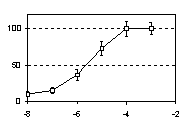Why !?
 European corn borer adult female. |
In the past years, we focused our research on European corn
borer (ECB). This insect is considered as polyphagous (recorded on
over 200 plant sp.) and can be found all over the world, in Europe as well
as in North America. It is considered as a major pest of corn. A wealth of
data is available on this insect, from ecological to physiological
observations. In addition, it is easily bread in the laboratory on an
artificial diet. We discovered that ECB larvae actively avoid food to which ecdysteroids are added. They detect them with their taste receptors. This is interesting because if this effect is confirmed, we could use ecdysteroids to enhance the resistance of their host plants.
|
Larval behavior

Larvae were offered a |
|
Legend: |
Larvae avoid food treated with 20-hydroxyecdysone (20E), in direct relation to the dose of 20E (Marion-Poll et Descoins, 2002). L1 larvae are repelled by 20E which is toxic to them [work of CÚcile Faucher & Adil Yattaf].
Electrophysiology
 Each galea bears 2 taste pegs |
|
Legend: number of action potential per second (ordinates) recorded with an electrode slipped over the lateral peg, containing 20E at different concentrations (abcissa, log10 molar units). |

